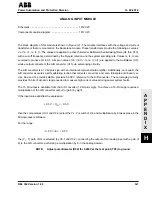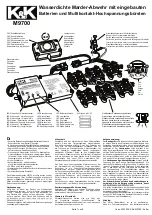
Power Automation and Protection Division
I.L. 40-201.9
REL 352 Version 1.00
I-1
I
A
P
P
E
N
D
I
X
ACCEPTANCE TESTS
1.
INTRODUCTION
The acceptance test of the relay verifies the operation of four subsystems.
• Analog Input
• Contact Input
• Relay Output
• Communication Interface
Additionally, Phase Comparison functional tests (simulating internal faults) are performed.
2.
EQUIPMENT NEEDED
Qty.
Description
1
REL 352 Relay
1
Doble, Multi-amp or equivalent 3-Phase Test System
3.
TEST SETUP
3.1.
Current and voltage Inputs
Connect the Relay Test System to REL 352 Relay, per application diagram 1618C33 (see SYSTEM DIA-
GRAMS section). Please note that the Relay Test System Simulates Power System shown on 1618C33.
Do not leave fault currents with trip relays energized for long periods of time.
3.2.
Power
Connect the primary and secondary dc power as shown on 1618C33. Consult the relay nameplate for rated volt-
age.
NOTE:
Before turning on dc power check jumper positions on the Contact Input and
Microprocessor modules. (See pages D-1 and E-2)
4.
ANALOG INPUT AND FRONT PANEL METERING TEST
STEP 1.
Turn on the primary and optional secondary dc input power if used. Make sure that the FREQ setting
matches the line frequency, and the RP setting is set to “NO” (Readout in secondary values). The “Relay
in Service” LED on the front panel should be lit.
STEP 2.
NOTE:
All ac voltage & current phase angles in this document are referenced to VA-G
voltage (0 degrees). Positive angles LEAD VA-G, negative angles LAG VA-G.
Fault impedance angles (FANG) are displayed as positive for inductive faults
and negative for capacitive.
















































